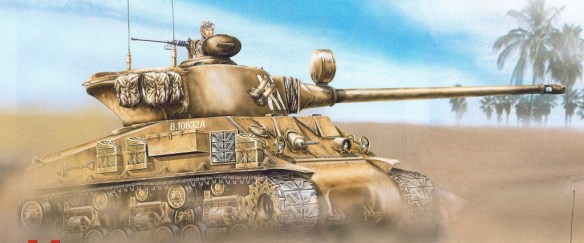
Israeli Super-Sherman.
Rugged, simple in design, easy to maintain and repair, and fast. The Sherman was an excellent tank with an incredibly long life; a number remained in service in some parts of the world for five decades after the end of World War II.
The United States also developed heavier tanks. The Sherman M4A3 and M4A3E8 medium tanks, the mainstay of U.S. armored forces at the end of World War II, continued in active service with the U.S. Army for a number of years after the war and fought with the United Nations Command (UNC) forces in Korea. As noted, there were many models and variants of the basic design, including dozers, 105mm howitzers, rocket launchers, tank retrievers, and flamethrowers. The M4A3E8 (76mm), the last production model of World War II, mounted a small metal box affixed to the right rear, containing an EE-8 sound-powered telephone, enabling an infantryman to communicate with the tank commander.
A great many Shermans were exported to other countries after World War II. Israeli Shermans, which were kept in operation for decades from a wide variety of sources, were also armed with an equally wide panoply of weapons, including antiradiation missiles. The French upgraded a number of the Israeli Shermans with 75mm and 105mm main guns. Known as M50 and M51 Super Shermans, these fought modified M4 Egyptian Army Shermans in the 1973 Yom Kippur War.
The United States was quick to recognize the new Jewish state, and during the war the United States became a major source of arms for Israel, providing a number of World War II–vintage M4 Shermans. The Israelis also secured surplus Shermans from other armies. These saw long service with the Israeli Defense Forces (IDF); they underwent a succession of upgrades, including heavier guns, improved engines, and modified turrets. Once they had reached the limit of possible improvements, a number were turned into self-propelled guns.
In its war to gain independence, Israel initially had only a small armored force, the 8th Armored Brigade, equipped with a hodgepodge of pre–World War II French Hotchkiss light tanks, World War II–era British Cromwells, and U.S. Shermans, the latter purchased from Italy and the Philippines. These faced the far more numerous tanks of Lebanon, Syria, Jordan, Egypt, and Iraq. During the fighting, Israel managed to form a second armored brigade, the 7th.
In the war the Israelis utilized their advantages of interior lines, higher morale, better leadership, and more effective command and control to defeat the larger and better-equipped Arab armies. The major Arab problems were in logistics and organization. The Arab armies were spread out (it was 700 miles from Baghdad to Haifa, and Egyptian forces relied on a 250-mile-long supply line across the Sinai Desert), and there was no unity of command or common military strategy.
After 1949 the Israeli Defense Forces invested heavily in tanks, and the Jewish state became one of the most skillful practitioners of armored warfare in history. Working in collusion with France and Britain against Egypt in 1956, Israel Super Shermans and French tanks rolled across the Sinai Peninsula (covering more than 150 miles in only four days) to take that vast desert area from Egypt. In the process Israeli armor defeated a far larger Egyptian force of Shermans, British Centurions, and some JS-3s, in addition to 230 Soviet T-34/85s, as well as a number of armored personnel carriers and self-propelled guns.
As in the War for Independence, in 1956 it was not superior equipment but rather better training, leadership, and motivation, as well as tactical doctrine and domination of the air, that were vital in the subsequent crushing Israeli victory. Although international pressure, largely from the United States, forced Israel (and Britain and France) to quit Egypt, the war led Israel to go over to a wholly mechanized ground force centered on tanks. The war also brought improved tanks into the Israeli inventory as well as better training. In June 1967 Israel used its highly mechanized forces to launch a devastating preemptive strike against Egypt and Syria, and then engage Jordan, in the Six Day War. Israeli tactics were similar to those employed by the Germans in their blitzkrieg of World War II. Tanks would break through the enemy front and then push forward, closely followed by mechanized infantry that would engage enemy forces. This armored thrust was followed by motorized infantry to mop up enemy resistance in order to allow the vital supply column to proceed forward. Rapid Israeli envelopments allowed the numerically inferior Israeli armored forces to take the heavier Arab tanks from the rear and make short work of the Arab armies. Israel had some 264,000 troops, 800 tanks, and 300 combat aircraft; Egypt, Saudi Arabia, Jordan, Kuwait, Syria, Lebanon, and Iraq had a combined strength of some 541,000 men, 2,504 tanks, and 957 combat aircraft. Of 1,200 Egyptian tanks before the war, 820 were lost. Israeli armor losses amounted to 122 tanks, many of which were repaired and returned to battle. There was also heavy fighting involving Israeli and Syrian tanks in Israel’s conquest of the Golan Heights, although the fighting there did not see the large-scale armor engagements that had marked combat on the Sinai front.